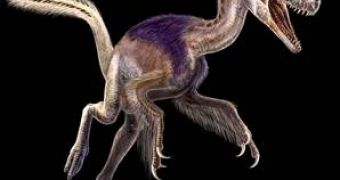One of the main characters in the Jurassic Park movie was a fierce T. Rex. However, back in the Jurassic period T. Rex didn't exist yet. But his ancestor from that period has now been unearthed by a team of archeologists near the Gobi desert. They have named the three-meter-long and one-meter-tall predator, which exhibits an elaborate crest along its snout, Guanlong wucaii, which means the "crowned dragon of the five-colored rocks".
The Jurassic period was roughly 160 million years ago and Guanlong wucaii lived in the Upper Jurassic, around 150 million years ago, in a period when the continents just started to break apart. T. rex, which measured about 12 meters long and 4.5 meters tall, lived during the last stage of the Cretaceous period about 65 million years ago.
The team found two specimens of Guanlong wucaii with five different carnivorous dinosaurs in an apparent mud pit. One specimen was a fully grown 12-year-old and the other one a still-developing six-year-old. The six-year old skeleton was almost intact.
Based on the presence of such characteristics as fused nasal bones and U-shaped teeth in the front of the upper jaw, the researchers were able to identify the creature as an early tyrannosaur. Its three-fingered hand, instead of the two found on most advanced tyrannosaurs, indicates that it was an early member of this family.
"This is an unbelievable discovery with tremendous new information on the evolution of the tyrannosaurs," said Xing Xu of the Institute of Vertebrate Paleontology and Paleoanthropology in Beijing, who led the team. This discovery sets back the clock on the tyrannosaur family by at least 30 million years. It is "a breakthrough in going deep in time to trace the evolution of coelurosaurs, a process culminating in the origin of birds".
John Francis, vice president for research, conservation and exploration at the National Geographic Society (NGS), which also supported the research, said the society "is thrilled to have played a part in the discovery of this important new tyrannosaur. This fossil adds significant new knowledge about a little-known prehistoric period."
The most important aspect of this discovery is that it shows that T. Rex has evolved from a species of earlier smaller predators. "Guanlong shows us how the small coelurosaurian ancestors of tyrannosaurs took the first step that led to the giant T. rex almost 100 million years later," said study co-author James Clark of George Washington University.
Another ancestor of the T. Rex, called Dilong paradoxus, is famous for its feathers. Scientists believe that "because they're so closely related, there's no reason at all to think it didn't have feathers", said Mark Norell of the American Museum of Natural History in New York and co-author of the study.
The most striking aspect of the new dinosaur is its large, complex, and fragile cranial crest that runs from its nose to the back of its head - which also gives its name. Guanlong is the only species of tyrannosaur known to have such a crest. Scientists can only speculate on the function of the exaggerated ornament. "It seems paradoxical that this predatory [group of animals] possessed a seemingly delicate, highly pneumatized cranial crest," Xing's team writes in its report on the findings, published today in Nature. The most probable idea is that it may have served to attract mates.

 14 DAY TRIAL //
14 DAY TRIAL //